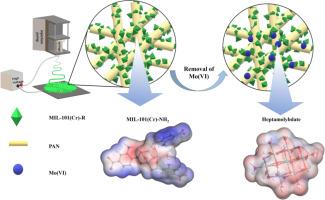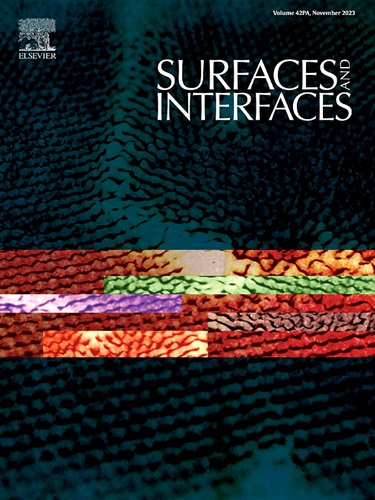电纺 MIL-101(Cr)-NH2/PAN 纳米纤维膜去除 Mo(VI) 的增强吸收能力和基本机制
IF 5.7
2区 材料科学
Q2 CHEMISTRY, PHYSICAL
引用次数: 0
摘要
全球对工业废水中重金属排放的关注不断升级,而钼(VI)作为一种潜在的有毒微量元素,对人类和环境健康构成了重大风险。生物降解和离子交换等传统处理方法的去除效率较低,因此,高效去除工业废水中的钼(VI)离子至关重要。新兴材料--金属有机框架(MOFs)因其强大的吸附性能在水处理领域受到广泛关注,MOFs 膜材料被誉为最有前途的吸附剂。因此,本研究旨在通过在纳米纤维中添加 MOFs,制备一种高效去除 Mo (VI) 的新型膜材料。考虑到 MIL-101 在水中的稳定性,本研究制备了具有不同官能团的 MIL-101-R(-H、-NH2、-NO2),并将其负载到 PAN 纳米纤维中以吸附 Mo(VI)。吸附动力学和等温线研究表明,PAN/MIL-101(Cr)-NH2 具有优异的吸附性能,最大吸附容量为 171.81 mg g-1。密度泛函理论(DFT)计算和分子动力学模拟阐明了吸附机理,突出了氨基修饰在通过静电吸引和高反应活性促进 Mo(VI) 吸附方面的作用。这项研究不仅为 Mo(VI) 废水处理提供了新材料和新方法,还推动了 MOF 材料在重金属废水处理领域的工业应用。本文章由计算机程序翻译,如有差异,请以英文原文为准。

Enhanced absorption capacity and fundamental mechanism of electrospun MIL-101(Cr)-NH2/PAN nanofibrous membranes for Mo(VI) removal
Amidst the escalating global concern over heavy metal discharge from industrial effluents, Mo(VI), as a potentially toxic trace element, poses significant risks to human and environmental health. Traditional treatment methods such as biodegradation and ion exchange have low removal efficiency, hence, the efficient removal of Mo (VI) ions from industrial wastewater assumes paramount importance. Emerging materials, Metal-Organic Frameworks (MOFs), have garnered extensive attention in water treatment due to their strong adsorption properties, and MOFs membrane materials are hailed as the most promising adsorbents. Therefore, this study aims to prepare a novel membrane material with high efficiency for the removal of Mo (VI) by loading MOFs into nanofibers. Given the water stability of MIL-101, MIL-101-R(-H, -NH2, -NO2) with different functional groups were prepared and subsequently loaded into PAN nanofibrous for the adsorption of Mo(VI). Adsorption kinetics and isotherm studies revealed PAN/MIL-101(Cr)-NH2 to exhibit superior adsorption performance, achieving a maximum adsorption capacity of 171.81 mg g-1. Density functional theory (DFT) calculations and molecular dynamics simulations elucidated the adsorption mechanism, highlighting the role of amino modification in facilitating Mo(VI) adsorption through electrostatic attraction and high reactivity. This work not only offers novel materials and approaches for Mo(VI) wastewater treatment but also advances the industrial application of MOF materials in the domain of heavy metal wastewater treatment.
求助全文
通过发布文献求助,成功后即可免费获取论文全文。
去求助
来源期刊

Surfaces and Interfaces
Chemistry-General Chemistry
CiteScore
8.50
自引率
6.50%
发文量
753
审稿时长
35 days
期刊介绍:
The aim of the journal is to provide a respectful outlet for ''sound science'' papers in all research areas on surfaces and interfaces. We define sound science papers as papers that describe new and well-executed research, but that do not necessarily provide brand new insights or are merely a description of research results.
Surfaces and Interfaces publishes research papers in all fields of surface science which may not always find the right home on first submission to our Elsevier sister journals (Applied Surface, Surface and Coatings Technology, Thin Solid Films)
 求助内容:
求助内容: 应助结果提醒方式:
应助结果提醒方式:


